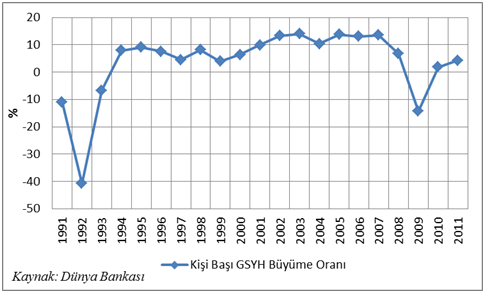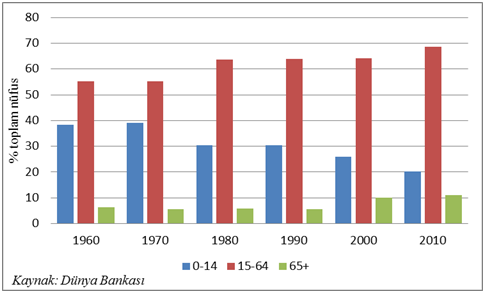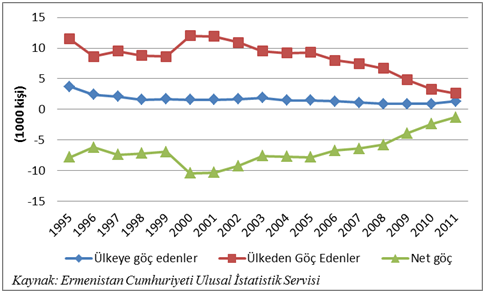The Analysis of Armenia’s Relations With Regional Countries from the First World War to Today Through Parameters Such as History, Economy, and Population
With the First World War and the period after it, the almost one thousand year old co-existence of Turks and Armenians came to an end to a large extent. The processes of minority nations gaining their independence, which the 1889 French Revolution and after-revolution France tried to create through the Napoleonic Wars, are called as the idea of nationalism and fundamentally had destructive effects on multi-national structures, gained speed (Karpat, 2009, p. 36-37). No matter how Armenia gained its independence in 1918, this situation did not last long and it was included in the Union of Soviet Socialist Republics (USSR). In the period until it regained its independence in 1991, by leaving this main structure, Armenia had to give most of its resources to Moscow like other states under the USSR. On the other hand, the nuclear plant Metzamor, which is often discussed in Turkey due to its danger for the region and is the only nuclear plant of the country, was also constructed during the Soviet rule. The economy of the country has also not been bright since its independence in 1991. As well as the lack of natural resources and its bad relations with neighbouring countries, resulted in Armenia’s economy to get even worse with every passing day. It is the second worst country’s economy in the world after Madagascar by 2011 (www.forbes.com). Even though there are some economic developments occasionally, Armenia could not actually reach prosperity since the day of its independence. Some data and explanations that we are going to put forth about Armenia’s recent past and today will also present this reality. The per capita income, population growth rate, age structure of population and migration, and reasons of migrations in Armenia will be understood better with the tables, graphics, and explanations that we are going to focus on. During the transmission of the date, per capita income will specifically have an emphasis put on and a general evaluation will be done about the others. According to this:
Table 1.
The per capita income in the country between the years 1992-2008 increased to 3 thousand 606 dollars from 31 dollars. The fact that the budget of Armenia is 5 billion dollars in 2006 shows how small the economy of the country is (www.dertlidolap.com). Armenia was especially affected by the global economic crisis, which affected the whole world in 2008 and caused the bankruptcy of large companies and banks, and could not still repair the crack caused by this crisis. It became 14.5% smaller in 2009 with the influence of this crisis. This also caused a decrease in the income of the country (http://ekonomi.haber7.com).
Graphic 1.
| Total Population (‘000) |
Population Growth Rate (%) | |
| 1959 | 1765,3 | – |
| 1970 | 2492,6 | 31,36415407 |
| 1979 | 3037,3 | 21,96029116 |
| 1989 | 3304,7 | 8,437673475 |
| 2001 | 3213,0 | -2,345051458 |
| 2011 | 3018,8 | -6,234567871 |
Source: National Statistical Service of the Republic of Armenia
We presented the numbers about the population after the per capita income of which the data and some explanations were provided above. Based on this table, we can conclude that the propaganda activities done to prevent the Turkish dominion in today’s Armenian lands under USSR rule in the historical period especially after the 1970s resulted positively and that the population migration was actually the result of the economic recovery achieved according to lands under Soviet rule. Similarly, another issue we can put forth based on the same table is that the population movements of the country took place in the opposite direction after the end of Soviet rule. While the population of the country was around 3 million 37 thousand in 1979, this number was around 3 million 18 thousand by 2011. As these numbers clearly put forward, there was a decrease in the population instead of an increase in the period of more than 30 years.
Table 2.
The age structure of the total population of the country in the period of ten years from 1960 until 2010 is given in this table according to World Bank data. A decrease is seen in the population of the 0-14 age range since 1980. On the other hand, the population over the age of 65 increased in the last 20 years. There is also an increase in the population of the 15-65 age range since 1980. All these data reveal that the young population in the country have decreased in the last 30 years. One of the most important reasons for this is the education problem and the other is the problem of employment. This situation, at the same time, leads to the increase in the female population and a decrease in the male population.
Table 3.
Table 4.
| According to Age Range | According to Sex |
||||
| 0-19 | 20-40 | 50+ | Male | Female | |
| Difficulty in finding job |
3,3 | 45,9 | 38,1 | 46,3 | 23,8 |
| Difficulty in finding job related to area of expertise | 1 | 5,2 | 4 | 5,1 | 3,2 |
| Not being able to earn enough income | 1,4 | 18,7 | 18,7 | 18,5 | 12,6 |
| Family reunification | 78,6 | 7,5 | 15,8 | 7,6 | 39,7 |
Source: National Statistical Service of the Republic of Armenia
The economic situation of the country resulted in the restriction of employment and areas of expertise, impoverishment of the people, and the tendency for family reunifications, as it can be seen in the table above as well. That is to say that the economic decrease in the country led to economic troubles and unemployment. This situation caused the people not to be happy about where they were and forced them to migrate to other countries, especially the USA and France. Another point to be considered is the family reunification which takes place when the people who migrated or had to migrate due to the reasons we listed above bring their spouses or other family members to the places they started to live and held onto the life there. This family reunification is among the elements causing a population decrease in the region.
Due to all these and similar reasons, the population of Armenia is decreasing with every passing day. The most important reason for the decrease in population is undoubtedly that migrated people don’t want to change the order that they established in the country they migrated to. With the reasons that the next generation of migrated people becomes natural citizens of that country as they grow up according to the dominant culture of the country they live in and that the homeland does not provide any attraction for a return, the population in Armenia doesn’t increase. If the people living in the country get an indecisive attitude towards having children in the coming years, this situation will definitely affect the future of the country negatively. When it is considered that the population is the most important element of an economy, it should be stated that the future of Armenia is even more pessimistic.
Russia in Armenia’s Policy of Looking for a Way Out
Armenians could be successful in establishing their own states as a result of the politics of Russians from whom they got support at the end of the First World War. We can briefly describe the politics of Russians as preventing the project of uniting the Turks in Anatolia with the Turks in Central Asia (Kumkale, 1997: 98-101). We come across Russia as the state which has the primary influence on Armenia today. Despite Armenia’s close cooperation with NATO, instead of openly revealing their goals of membership to NATO, Armenian authorities stated that Armenia would not become a member of NATO, and that the military technical cooperation with the Collective Security Treaty Organization under the CIS and Russia would be maintained. This attitude is especially caused by the strategy of Armenia not to take a step back in the issue of Nagorno-Karabakh (Karagül, 2006: 132).
On the contrary of the relations developed with Russia, the leading country which Armenia has problem with in the region is Azerbaijan. While Armenia supported by Russia was dreaming of capturing the eastern lands of Turkey, it also intended to end the dominion of Azerbaijan in the region, on the other hand. After Armenia became an independent state after separating from the Soviets, the Armenia-Azerbaijan War, which made itself heard by the world in the Khojaly Massacre, started and when the war ended, Nagorno-Karabakh remained under the occupation of Armenians. This problem which is called the Nagorno-Karabakh problem and portrays the crisis between the two countries today, also displays the disagreement of both sides.
In terms of showing the alliance between Russia and Armenia, it is sufficient to state that Russia is the country which makes the biggest investment in Armenia’s economy with 180 million dollars. Also, the reflection of the Russian-Armenian alliance on the military is clearly seen in that Russian President Vladimir Putin signed the ‘Treaty on Long-Term Economic Cooperation for a Period up to 2010’ and with the statement of the Article 2 of ‘The Treaty of Friendship, Cooperation and Mutual Aid’ which Petrosyan signed in August 1997: “…If the parties in agreement confronts any armed attack danger or is assaulted, they will immediately start negotiations with the other party signing the treaty and provide the defence and they will co-act to protect the peace and security.” We can conclude this also from Article 3 which says, “…In case any threat of peace and security by any state or group of states, the parties in agreement will help each other including military help as required by the Article 51 of the UN treaty to ensure the peace and security” and also from the fact that Russia gratuitously sent weapons at a cost of around 1 billion dollars to Armenia between the years 1993-1996. Also Russia has military bases in Armenia. Even these few instances related to the cooperation of Russia with Armenia from whom it benefits to maintain its dominance in the region reveal both the importance of Armenia for Russia and the importance of Russia for Armenia (Cabbarlı, 2004: 23).
İran’ın Kafkaslarda Ermenistan’la Etkinlik Artırma Gayretleri
Iran is another country which Armenia is in alliance with in the region. If we are to briefly mention the importance of Iran’s alliance with Armenia, the main reason of it is that Iran has been in competition with Turkey in the region for a very long time. The competition between Iran and Turkey for a long time is in favor of Armenia. The fact that any country has problematic relations with Turkey meant a potential cooperation between this country and Armenia. Armenia indeed applies to benefitting from this competition. As a result of this, there are quite often diplomatic visits between the two countries. The first relations were established in the second year of Armenia’s independence in February 1992 and a series of economic treaties were signed between the two countries during the years when the Armenia-Azerbaijan war was on. Armenia signed a treaty with Iran in April 1992 when the Nagorno-Karabakh war was on-going. According to the conditions of the treaty, Iran would give support to Armenia on the issues of natural gas, fuel, and lines of communication. The relations between the two countries in the field of defense have also been developed and are being developed. The Iranian Defense Minister, Ali Shamhani, arranged a visit to Armenia in March 2002. During this visit, he signed a letter of intent in the military field with the Armenian Defense Minister Sej Sarkisyan. In the context of Armenia-Iran relations, we can similarly handle the two-day visit of Armenian Defense Minister Seyran to Iran in July 2010. The fact that Ohanyan discussed especially the bilateral relations and global and regional developments with Iranian President Mahmud Ahmedinejad, Iranian Defense Minister Ahmed Vahid, Foreign Affairs Minister Manucher Muttaki, and National Security Council General Secretary Said Jalili shows that the alliance still continues to exist (1 News, 25.01.2011).
Although Armenia attempted negotiations to eliminate the problems with Turkey and Azerbaijan, no solid results could be obtained from these negotiations. Due to its politics based on Turkish and Azerbaijani hostility, which Armenian internal politics and Diaspora Armenians use as an instrument for not losing their identity, Armenia is losing every passing day. The fact that Turkey started active politics in the region also caused Armenia to intensify its relations with Russia and the image of Russia as the satellite state in the region to speed up. This situation, which is also a reflection of the fact that the income coming from diaspora is not wanted to be cut, prevents the country from reaching economic prosperity. The country needs to relieve their hatred coming from history to be able to open up to Europe. Armenian President Sej Sarkisyan responded to the question “Will we be able to get out western lands with Mount Ararat?” by young Armenians in a meeting: “This depends on your generation. For example, my generation did their duty. We saved Artsah, which is the part of our homeland from the enemy, in the 90s. Every generation has a duty. Whether you will also, like us, perform your duty in the future or not depends on your unity and solidarity. We, the Armenian nation, have always succeeded in reviving from the ashes like a phoenix. But I should also say this. The reputation of the countries is not measured with the surface area in today’s world. If Armenia becomes a modern, secure, and economically successful country, its reputation will also rise to the same extension.” As we can see in this answer as well, the grudge kept alive has caused Armenia to lose.
The so-called genocide claims which are directed by Armenia and its diaspora and troubled Turkey to a large extent, especially in the periods of its weakness, also prevent the effective run of activities to ease the historical distress of the two countries. Before this situation, Turkey has tried to get economically strong and become a stable country in the region. Turkish Foreign Affairs Minister Ahmet Davutoğlu revealed the politics to be followed against the Armenian Diaspora in his speech at the 4th Ambassadors Conference in Ankara on 23 December 2011. Davutoğlu said in his speech that any individual who migrated from Anatolian lands would constitute the diaspora of Turkey and he demanded that Armenians who migrated from Anatolian lands should therefore, be followed closely by Turkish diplomats and should be taken care of. Both the economic growth and foundation and development of friendship relations are interesting for being the important elements for Turkey in solving this important problem.
Bibliography
http://www.forbes.com/sites/danielfisher/2011/07/05/the-worlds-worst-economies/, 07.05.2011.
“Ermenistan’ın Durumu“http://www.dertlidolap.com/index.php?option=content&task=view&id=Itemid=24, 20.04.2013.
“ErmenistanekonomisiTürkiye’yemuhtaç”,http://ekonomi.haber7.com/ekonomi/haber/7634847- ermenistan-ekonomisi-turkiyeye-muhtac, 13.07.2011.
“İran, Ermenistan’ı Neden Besliyor?”, 1News, 25.01.2011.
Cabbarlı, Hatem (2004), Bağımsızlık Sonrası Ermenistan-Rusya İlişkileri, Yer (?)
Karagül, Soner, Ermenistan’ın Bağımsızlık Sonrası Avrupa İle İlişkileri, AOKA, B.1, V.2, p.132.
Karpat, Kemal (2009), Osmanlı’dan Günümüze Kimlik ve İdeoloji, Istanbul.
Kumkale, Tahir Tamer (1997), Tarihten Günümüze Türk-Rus İlişkileri, Istanbul.
Şenyurt, Ali Haydar (2012), İran-Ermenistan İlişkileri: Tecride Karşı Dayanışma, BİLGESAM.
Categories
- Experience of Living Together of Turks and Armenians
- Demographic Structure of Armenians in the Ottoman Lands
- Disturbances in Anatolia: Protests and Anarchy
- Armenians and the International System: Seeking a Solution
- Historiography in Turkish-Armenian Relations
- Dispatchment and Settlement: Discourses of Genocide
- Trials and International Law
- Armenians in Society and Bureaucracy
- Armenian Diaspora
- Church, Identity, and Social Structure



